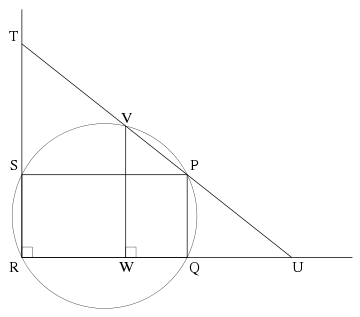Philo line
In geometry, the Philo line is a line segment defined from an angle and a point. The Philo line for a point P that lies inside an angle with edges d and e is the shortest line segment that passes through P and has its endpoints on d and e. Also known as the Philon line, it is named after Philo of Byzantium, a Greek writer on mechanical devices, who lived probably during the 1st or 2nd century BC. The Philo line is not, in general, constructible by compass and straightedge.
Doubling the cube
Philo's line can be used to double the cube, that is, to construct a geometric representation of the cube root of two, and this was Philo's purpose in defining this line (Coxeter and van de Craats, 1993). Specifically, let PQRS be a rectangle in which the aspect ratio PQ:QR is 1:2, as in the figure below. Let TU be the Philo line of point P with respect to right angle QRS. Define point V to be the point of intersection of line TU and of the circle through points PQRS, and let W be the point where line QR crosses a perpendicular line through V. Then segments RS and RW are in proportion .

In this figure, segments PU and VT are of equal length, and RV is perpendicular to TU. These properties can be used as part of an equivalent alternative definition for the Philo line for a point P and angle edges d and e: it is a line segment connecting d to e through P such that the distance along the segment from P to d is equal to the distance along the segment from V to e, where V is the closest point on the segment to the corner point of the angle.
Since doubling the cube is impossible with compass and straightedge, it is similarly impossible to construct the Philo line with these tools.
References
- Coxeter, H. S. M.; van de Craats, Jan (1993). "Philon lines in non-Euclidean planes". Journal of Geometry. 48 (1–2): 26–55. doi:10.1007/BF01226799. MR 1242701.
- Eves, Howard (1959). "Philo's line". Scripta Mathematica. 24: 141–148. MR 0108755.
- Eves, Howard (1965). A Survey of Geometry (vol. 2 ed.). Boston: Allyn and Bacon. pp. 39, 234–236.
- Kimberling, Clark (2003). Geometry in Action: A Discovery Approach Using The Geometer's Sketchpad. Emeryville, California: Key College Publishing. pp. 115–6. ISBN 1-931914-02-8.
- Neovius, Eduard (1888). "Ueber eine specielle geometrische Aufgabe des Minimums". Mathematische Annalen. 31 (3): 359–362. doi:10.1007/BF01206220.
- Neuberg, J. (1907). "Sur un minimum". Mathesis: 68–69.
- Wetterling, W. W. E. (1996). "Philon's line generalized: an optimization problem from geometry" (PDF). Journal of Optimization Theory and Applications. 90 (3): 517–521. doi:10.1007/BF02189793. MR 1402620.